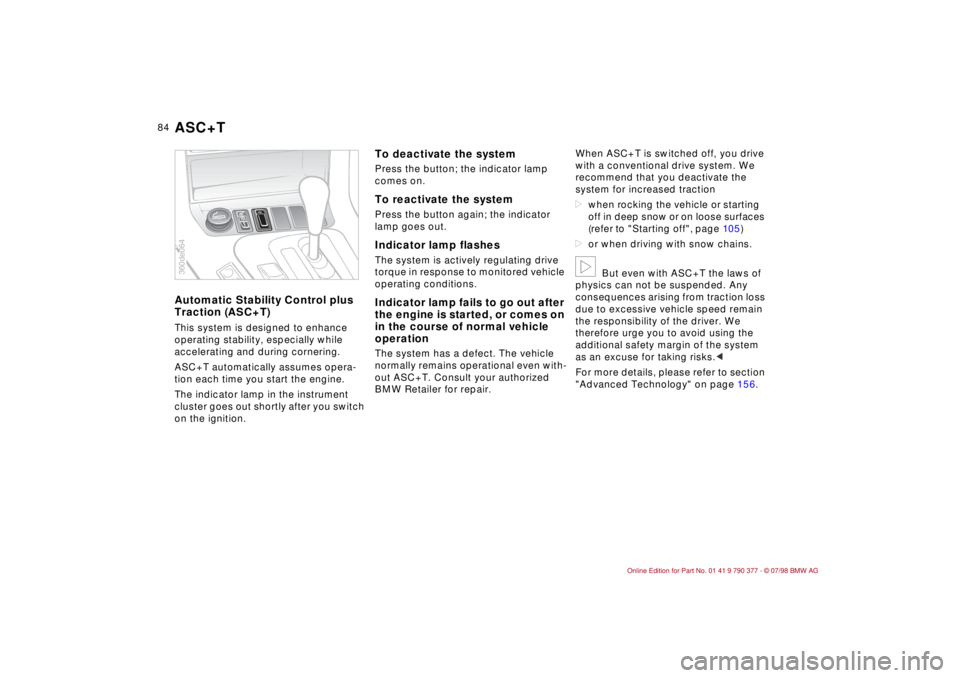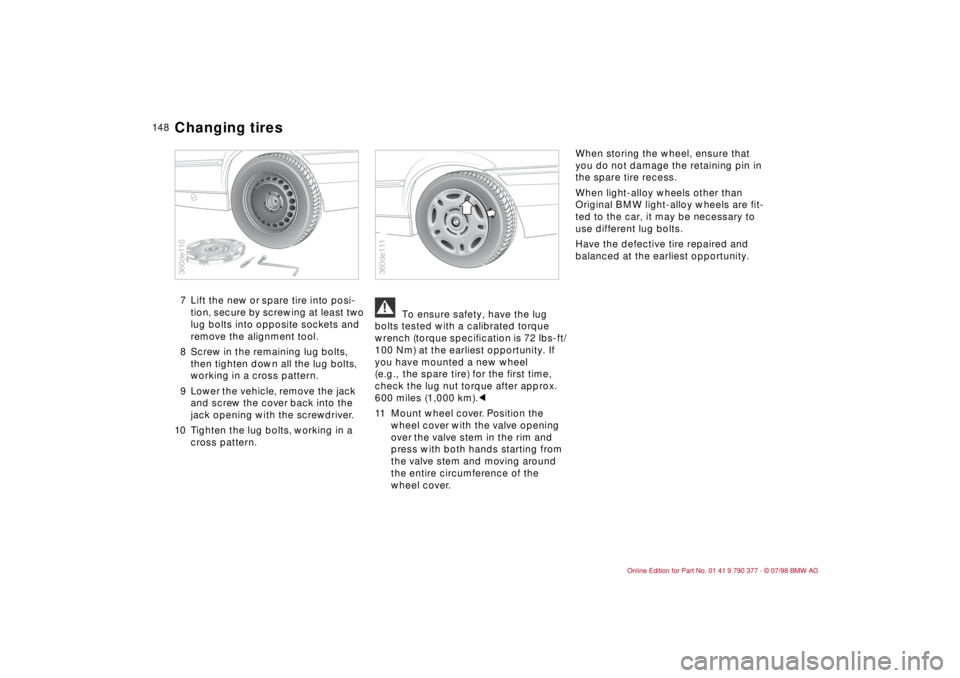Page 85 of 179

84
Automatic Stability Control plus
Traction (ASC+T)This system is designed to enhance
operating stability, especially while
accelerating and during cornering.
ASC+T automatically assumes opera-
tion each time you start the engine.
The indicator lamp in the instrument
cluster goes out shortly after you switch
on the ignition.
To deactivate the systemPress the button; the indicator lamp
comes on.To reactivate the systemPress the button again; the indicator
lamp goes out.Indicator lamp flashesThe system is actively regulating drive
torque in response to monitored vehicle
operating conditions.Indicator lamp fails to go out after
the engine is started, or comes on
in the course of normal vehicle
operationThe system has a defect. The vehicle
normally remains operational even with-
out ASC+T. Consult your authorized
BMW Retailer for repair.When ASC+T is switched off, you drive
with a conventional drive system. We
recommend that you deactivate the
system for increased traction
dwhen rocking the vehicle or starting
off in deep snow or on loose surfaces
(refer to "Starting off", page 10 5)
dor when driving with snow chains.
b
But even with ASC+T the laws of
physics can not be suspended. Any
consequences arising from traction loss
due to excessive vehicle speed remain
the responsibility of the driver. We
therefore urge you to avoid using the
additional safety margin of the system
as an excuse for taking risks.c
For more details, please refer to section
"Advanced Technology" on page 156.
ASC
360de064ASC+T
Page 149 of 179

14 8
7 Lift the new or spare tire into posi-
tion, secure by screwing at least two
lug bolts into opposite sockets and
remove the alignment tool.
8 Screw in the remaining lug bolts,
then tighten down all the lug bolts,
working in a cross pattern.
9 Lower the vehicle, remove the jack
and screw the cover back into the
jack opening with the screwdriver.
10 Tighten the lug bolts, working in a
cross pattern.
a
To ensure safety, have the lug
bolts tested with a calibrated torque
wrench (torque specification is 72 lbs-ft/
100 Nm) at the earliest opportunity. If
you have mounted a new wheel
(e.g., the spare tire) for the first time,
check the lug nut torque after approx.
600 miles (1,000 km).c
11 Mount wheel cover. Position the
wheel cover with the valve opening
over the valve stem in the rim and
press with both hands starting from
the valve stem and moving around
the entire circumference of the
wheel cover.When storing the wheel, ensure that
you do not damage the retaining pin in
the spare tire recess.
When light-alloy wheels other than
Original BMW light-alloy wheels are fit-
ted to the car, it may be necessary to
use different lug bolts.
Have the defective tire repaired and
balanced at the earliest opportunity.
360de110
BMW
360de111
Changing tires
Page 157 of 179

15 6
Deceleration sensors continuously
monitor the physical forces acting upon
the vehicle. If a frontal impact results in
deceleration, for which the protection
afforded by safety belts no longer suf-
fices, the gas generators of the driver's
and the passenger's airbags ignite
simultaneously. The passenger's air-
bag is activated only when a special
sensor indicates that the front passen-
ger's seat is occupied.
In the event of a severe side impact the
side airbag
* is activated on the side on
which the impact occurred.
The airbags, which are under the cover
of the steering wheel, in the instrument
panel or the side trim panels of the front
doors, are deployed and inflated by the
gas within a few milliseconds. In the
process they tear or push apart the pro-grammed separation points in their
upholstered covers.
Because the inflation process must be
virtually instantaneous, it is necessarily
accompanied by a certain amount of
ignition and inflation noise. The gas
which the system employs to inflate the
airbag is not dangerous, and the asso-
ciated smoke is quickly dissipated.
The entire process is completed within
one twentieth of a second.Automatic Stability Control plus Trac-
tion helps maintain stable and con-
trolled vehicle response by inhibiting
slip at the drive wheels.
The system employs special sensors to
monitor wheelspeed and relay the data
to the system's electronic control unit,
which uses this information to calculate
slip rates at the individual wheels.
Depending on the driving situation, two
forms of remedial action can then be
taken by the system: it reacts to slip-
page caused by large amounts of
excess torque by instructing the engine
management system to reduce power
output. As a supplementary measure,
the system will also respond to an
especially pronounced tendency to-
ward traction loss at either of the drive
wheels with automatic individual appli-
cation of the affected wheel's brakes.
This achieves a locking action compa-
rable with a controlled limited-slip dif-
ferential. This brake action is active up
to 25 mph (40 km/h). From 25 mph
(40 km/h) upward, a diminished brake
action improves the traction up to
60 mph (100 km/h).
390de012Airbags ASC+T*
Page 161 of 179
16 0
Engine speciÞcations
BMW 318i Sedan
BMW 318is Coupe
BMW 318i ConvertibleBMW 323is Coupe
BMW 323i ConvertibleBMW 328i Sedan
BMW 328is Coupe
BMW 328i Convertible
Displacement
Number of cylinderscu.in (cmm) 115.6 (1,895)
4152.2 (2,494)
6170.4 (2,793)
6
Maximum output
at engine speedhp
kW
rpm138
103
6,000168
125
5,500190
142
5,300
Maximum torque
at engine speedlb-ft (Nm)
rpm133 (180)
4,300181 (245)
3,950206 (280)
3,950
Compression ratioe10 10.5 10.2
Stroke
Borein. (mm)
in. (mm)3.29 (83.5)
3.35 (85)2.95 (75)
3.31 (84)3.31 (84)
3.31 (84)
Fuel-injection system Digital-electronic engine-management system